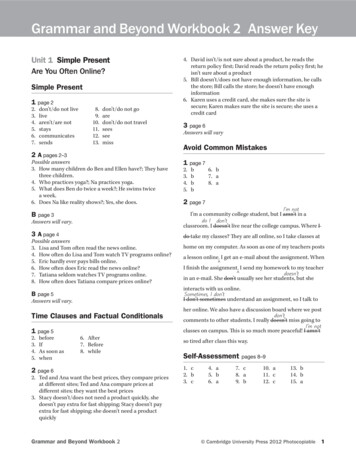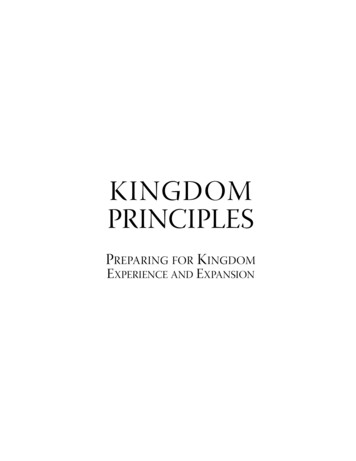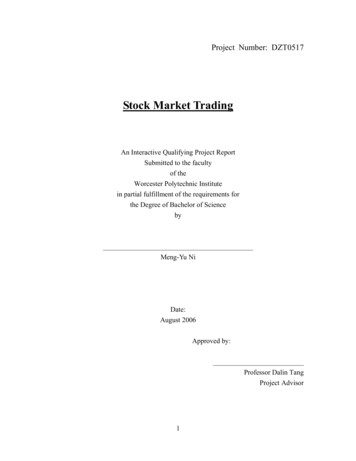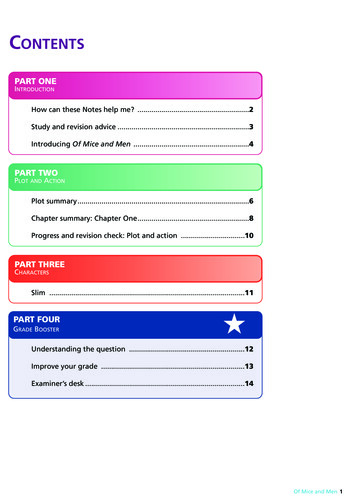
Transcription
Letting Go:Recognizing Codependent Behavior Presented byFran Campbell, MSN, RN, MEd, PMHCNS-BC, CARNBonnie Franckowiak, DNP, FNP-BC, CARN-AP IntNSA Annual ConferenceDenver, CO2018OR Why they can’t let go.“It is better to know someof the questions --than all of the answers”1
Codependency “Codependency Operationalized” A picture is worth a thousandwords!!A picture is worth a thousand wordsCodependency: Origin of the Concept Prior to the term “chemical dependency”family members and spouses of alcoholicswere called co-alcoholics When the term “chemical dependency”began to be used, spouses were calledcodependents2
Codependency: RootsThe codependency movement has its roots inthe theories of German psychoanalyst KarenHorney (the first feminist psychoanalyst)In 1941she proposed her theory that somepeople develop a “Moving Toward”personality style(cont.)Codependents tend to “move toward”and attach to a personality that is somewhat“vulnerable and needy”Karen Horney believed that this behaviorwas a way of dealing with a deep seededanxiety and insecurityCodependency: The ProcessThese individuals move “toward others” to“try to help them,” but the real goal of theinteraction is to gain their approval andaffection and subconsciously “control them”using a very dependent and manipulativestyle of behavior“ I’m only trying to help you”3
(cont.)Dr. Horney believed that this style ofinteraction seen in codependency is areaction to dysfunctional parenting.In childhood, these individuals had critical,indifferent, rigid, abusive, or unavailableparents(cont.)They develop a helping stance, and try toget approval through their “behavior” ratherthan feeling valued just because they exist.“Approval from Others”is more important than respectingthemselvesCodependencyThe term is attached to a person who isinvolved in a highly dependent relationshipwith an individual who requires “extra careor vigilance” – such as (but not limited to) anaddiction.It could be applied to any dysfunctionalrelationship or situation4
Timmen Cermak MD, a Neurologist andPsychiatrist, proposed that Codependencybe listed as a personality disorder in theDSMHe reasoned that when specific personalitytraits become excessive and maladaptiveand cause significant stress anddysfunction it warrants the status of apersonality disorderHowever, it has not been recognized by theAmerican Psychiatric Association forinclusion in the Diagnostic Statistical Manualof Mental Disorders, as a personalitydisorder or any other Axis I or Axis IIdiagnosisCodependency: DefinitionEven on a broader scale – there is “noaccepted definition” of CodependencyIn 1989, 22 leaders in the field convened ata national conference and came up with atentative definition of codependency5
A “somewhat” accepted definitionCodependency is a pattern of painfuldependence upon compulsive behaviorsand approval of others to find safety, selfworth and identity. It is developed inchildhoodDefinition (cont.)Just as the definition of the term is notagreed upon by those in the field, thesymptoms are also varied and not “agreed”upon by allCodependencyCodependents present asunselfishvirtuousmartyr – likefaithful“turn the other cheek” despite personalhumiliation6
Because the presentation of thecodependent is such a “positive” list ofqualities - Its important to distinguish whatcodependency is not:Codependency Is Not CaregivingCaregiving comes from abundanceCodependency “caretaking” comes fromneed and deprivationCodependency Is Not KindnessIt is natural and satisfying to be kind andhelpful to othersCodependents don’t have a choice – they“can’t say no”Are you giving from a place of self-esteemor from guilt, fear or insecurity7
Symptoms of Codependency ShameLow self-esteemPeople pleasingGuiltFearShameAccording to Karen Horney, shame developsin childhood as a defense against the child’sanger at the parent’s unfair treatment:- an inner sense of being diminished orfeeling insufficient as a person- the premise that one is fundamentally bad,inadequate, defective unworthy – not fullyvalid as a human beingAuthors who addressed Shame Freud – (1942) defined shame as a reaction formationagainst exhibitionism Erickson – (1950) shame and doubt is the secondnuclear conflict” its resolution leads to self esteem andautonomy Piers and Singer – the implied threat of shame isabandonment Wurmser (1981) it is the anxiety connected withexposure, humiliation and rejection8
Current authors who havewritten about Shame Gershen Kaufman: Shame: The Power ofCaring John Bradshaw: Healing the Shame ThatBinds YouGershen Kaufman“shame breaks the interpersonal bridge”it prevents intimacy because theindividual fears revealing his “trueself” which he/she believes is flawedand unworthyJohn Bradshaw Shame at some levels can be healthy Healthy shame teaches us about our limitsand helps us set boundaries Individuals struggling with shame cannotset boundaries9
“Everyone needs a sense of shame but noone needs to feel ashamed”Frederick NietzscheSelf EsteemReflects how you think about yourselfWith codependents self esteem is“other defined”Signs of low self esteem Never enoughDefer to othersOverly sensitive to criticismDeflect praiseDislike attention10
People Pleasing Desperately try to accommodate others Need others to validate them Need others to accept them The more you look outward for validationthe greater is your estrangement from theselfGuilt A feeling about what you have “done” Codependents are “Always sorry”Fear Fear is the underlying emotion motivatingmanipulation and control11
Masterson Masterson in his theories about the“disorders of the self” addressed the issueof abandonment “Abandonment Depression” he says is atthe core of the development of personalitydisorders (codependency) and addiction.CodependencyBeyond families, friends, and loved ones:Codependency is also seen in individuals inthe helping professions12
In the therapeutic process symptoms thatmay indicate the therapist is working froma codependent stance:* “working harder than the client”* “burnout”Codependency and NarcissismThere is a strong relationship betweenCodependents and NarcissistsNarcissists seek relationships withsubservient individuals who will reinforcetheir feelings of superiority and powerCodependency and Narcissism A codependent partner is ideal for theNarcissist Codependents have a tendency to getinvolved with a narcissist in toxicrelationships13
Connection to Addiction When addicts break their addiction, theythen must deal with their emotions They must face the relationship andintimacy problems they have avoided viatheir addictionsIn RecoveryMany of the issues they must confront arethe underlying problems of codependencyThey are asked to make a list of theirCharacter DefectsCharacter Defects Frequently identified character defectsinclude:People pleasingIsolation – a function of shameControlling behaviorsPerfectionism14
Character defects seen in addicts are thesame as the behaviors seen inCODEPENDENCYWorking the StepsProvides a framework for making changes tothe behaviors that if not dealt with will leadback to addictive behaviorsThe five things people getaddicted to1. A drink2. A drug3 A cookie (food)4 A person5. A behavior15
KARPMAN TRIANGLEKarpman Triangle Comes from transactional analysis“I’m Okay, You’re Okay”“Games People Play”Eric BerneFutile interactionsProblems remain unsolvedDRAMARESCUEVICTIMPERSECUTORINTIMACY16
Melody Beattie A seminal figure in codependencyliterature:Codependent No MoreBeyond CodependencyLanguage of Letting GoCodependency QuizCan be used in any type of ependency-quiz-2/(cont.) 60 questions Self-administered Scoring instructionsIf your score is.Below 20 You have Little Need for Concern21 - 30 Moderate Need for Concern.31 - 45 Moderate to Severe Need for Concern.46 or over Severe Need for Concern & Intervention17
Codependency Quiz The Friel Co-Dependency AssessmentInventoryhttp://www.mhankyswoh.org/Home Also 60 questions Same scoring system More of a self-assessmentAnother selfself-assessment Spann-Fischer 16 questions 6-point Likert scale Answer questions about self18
A FINAL THOUGHT 19
Sometimes holding on hurts morethan letting go THANK YOU!20
codependency is not: Codependency Is Not Caregiving Caregiving comes from abundance Codependency "caretaking" comes from need and deprivation Codependency Is Not Kindness It is natural and satisfying to be kind and helpful to others Codependents don't have a choice - they "can't say no" Are you giving from a place of self-esteem






![[Page 1 – front cover] [Show cover CLEAN GET- AWAY 978-1 .](/img/13/9781984892973-6648.jpg)




